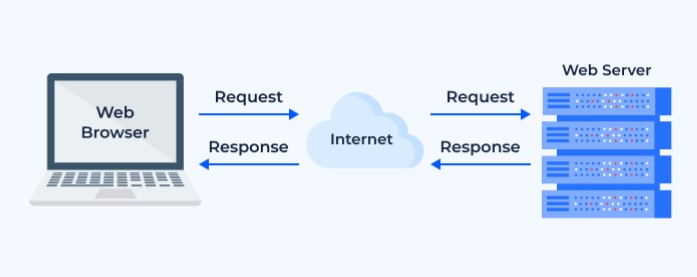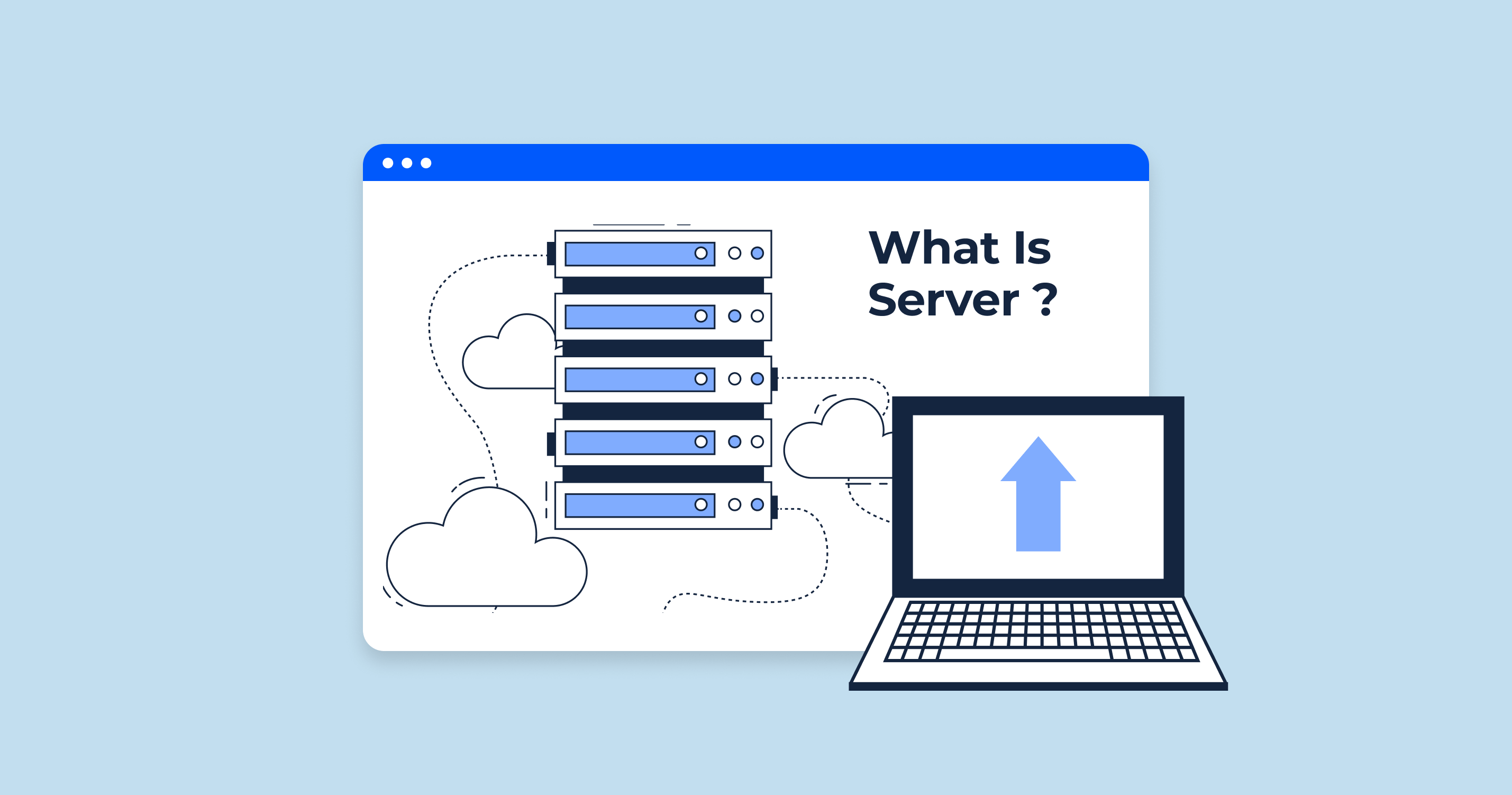What Is a Server?
A server is a specialized computer or software system designed to provide resources, data, services, or programs to other computers, known as “clients,” over a network. In essence, servers “serve” clients. Servers can be found in various forms, from dedicated hardware to cloud-based systems, and can be used for various purposes, such as hosting websites, managing emails, or storing files.
Key components of a server
Servers, while specialized, share many of the same fundamental components as standard computers. However, these components are often designed for more robust, reliable, and continuous operation. Here are the key components:
| Processor (CPU) | Servers usually have multi-core processors or even multiple processors to handle large workloads. |
| Memory (RAM) | Servers typically have a larger RAM capacity than personal computers to handle multiple tasks and simultaneous requests. |
| Storage | This can include multiple hard drives, often set up in a RAID (Redundant Array of Independent Disks) configuration for data redundancy and faster access. |
| Network Interface Card (NIC) | Essential for connecting the server to a network. Some servers have multiple NICs for redundancy and improved performance. |
| Power Supply Unit (PSU) | Many servers come with redundant power supplies, ensuring they remain operational even if one PSU fails. |
| Cooling System | Given the continuous operation and workload, servers have robust cooling systems to prevent overheating. |
| Motherboard | Specially designed for server operations, it supports multiple CPUs, RAM modules, and expansion slots. |
| Software | Depending on its purpose, a server will run specific server software. Examples include Apache for web servers or Microsoft Exchange for mail servers. |
How does a server work?
At its core, a server processes incoming network requests and provides responses. Here’s a simplified step-by-step breakdown:

- Connection Establishment: When a client wishes to connect, it sends a request to the server. The server, always waiting for incoming requests, accepts the connection.
- Request Processing: Once connected, the client sends a specific request (e.g., asking for a webpage or downloading a file). The server receives and processes this request.
- Resource Access: The server accesses the necessary resources or data to fulfill the client’s request. This could involve retrieving a specific webpage, fetching data from a database, or accessing a requested file.
- Response: After processing the request and accessing the necessary resources, the server sends a response back to the client. This could be in the form of a webpage, data packet, or a confirmation message.
- Connection Termination: Once the request has been fulfilled and the response sent, the connection between the client and server can be terminated. However, in some cases, the connection remains open for further interactions.
- Continuous Availability: Servers are typically designed to operate 24/7, continuously listening for and responding to requests from multiple clients simultaneously.
In essence, the fundamental role of a server is to be available and ready to fulfill requests, ensuring the necessary resources are delivered to clients efficiently and accurately.
Types of Servers
Servers can be categorized based on their specific functions and the services they offer. Here’s a look into some of the most common types of servers:
1. Web server
A web server is responsible for storing and serving web pages to users. When you access a website through your browser, your request is directed to a web server, which then provides the necessary web page. Web servers use HTTP (HyperText Transfer Protocol) to communicate.
Examples: Apache HTTP Server, Nginx, Microsoft Internet Information Services (IIS).
2. Mail server
Mail servers handle and manage emails. They receive incoming emails for the domain, store them, and then send them to the intended recipient when they connect and request their mail.
Examples: Microsoft Exchange, Sendmail, Postfix.
3. Application server
Application servers run specific applications and present them to end users. These servers often use the client-server model, where the client requests the app’s functionality, and the server processes the request and returns the results.
Examples: Apache Tomcat, IBM WebSphere, Microsoft .NET.
4. Database server
A database server stores, retrieves, and manages data in a database. It responds to requests from client machines (queries, updates, and database commands).
Examples: MySQL, Oracle Database, Microsoft SQL Server.
5. DNS server
Domain Name System (DNS) servers translate domain names (like www.example.com) into IP addresses, making websites accessible to users. It acts as an internet directory.
Examples: BIND, Microsoft DNS, Google Public DNS.
6. Proxy server
Proxy servers act as intermediaries between end users and the internet. They can be used to cache information, filter content, manage network loads, and anonymize users.
Examples: Squid Proxy, NGINX, Apache Traffic Server.
7. DHCP server
Dynamic Host Configuration Protocol (DHCP) servers automatically assign IP addresses and other network configurations to devices on a network, making network connections seamless and straightforward.
Examples: ISC DHCP, Microsoft DHCP, Cisco DHCP.
8. File server
File servers store and manage files, allowing network users to access shared files and folders. They can provide backup, access controls, and data management.
Examples: Microsoft File Server, Samba, Network Attached Storage (NAS) devices.
9. Gaming server
Gaming servers are specialized servers that host multiplayer online games. They handle the game logic, player data, and game states, ensuring a smooth gaming experience for players.
Examples: Minecraft servers, World of Warcraft servers, Counter-Strike servers.
10. Print server
A print server connects printers to client computers over a network. It manages print requests, queues them, and communicates with the printers to ensure documents are printed correctly.
Examples: Windows Print Services, CUPS (Common Unix Printing System), HP JetDirect.
Understanding the distinctions between these types of servers ensures that the right server is chosen for its intended purpose, ensuring efficiency and functionality for users and administrators alike.
Server Structures
The architecture and setup of servers can vary based on the need, scalability, redundancy, and the specific roles they serve. Below are some common server structures:
Mainframe or minicomputer (AS/400)
Mainframes and minicomputers, such as the AS/400 (now known as IBM iSeries), are powerful computing systems primarily used by large organizations for mission-critical applications, bulk data processing, enterprise resource planning, and transaction processing. They offer robustness, scalability, and can handle a vast number of simultaneous users and tasks.
Features:
- High processing power.
- Built-in redundancy.
- Ability to run multiple operating systems and applications.
Computer hardware server
These are the traditional physical servers, which include a standalone machine with its processor, memory, storage, and network connections. They are the backbone of many IT environments and can be tailored based on specific requirements, from lightweight tasks to heavy-duty processing.
Features:
- Customizable based on need.
- Direct access to physical resources.
- Can be equipped with redundant components.
Blade servers
Blade servers are a compact solution that houses multiple server modules (“blades”) in a single chassis. Each blade can operate as its server but shares resources like power, cooling, and networking with other blades in the chassis.
Features:
- Space-saving design.
- Energy efficiency due to shared resources.
- Quick scalability by adding more blades.
Combining servers
This involves clustering multiple servers to function as a single system. Server clustering is primarily used to ensure high availability, load balancing, or fault tolerance. If one server fails, another from the cluster can take over, ensuring continuous service.
Features:
- Redundancy and high availability.
- Improved performance by load balancing.
- Simplified system management.
Virtual servers
Virtual servers are software-based servers that run on physical server hardware, using hypervisors like VMware or Hyper-V. A single physical server can host multiple virtual servers, each with its operating system and applications. This structure maximizes the use of hardware resources and allows for flexibility and scalability.
Features:
- Efficient utilization of physical resources.
- Isolation: If one virtual server fails, others remain unaffected.
- Quick deployment and easy management.
The chosen server structure often depends on the specific requirements of an organization, including its budget, performance needs, growth predictions, and desired redundancy levels. By understanding these different structures, businesses can make informed decisions about their IT infrastructure.
Key Features of Servers
Servers, being the backbone of many IT operations and online activities, are designed with features that differentiate them from standard desktop computers. These characteristics ensure that servers efficiently handle the tasks they’re assigned, from hosting websites to managing vast databases. Below are some of the key features of servers:
1. High processing power
Servers often have more potent processors, sometimes multiple CPUs, and more cores per CPU than a typical personal computer. This high processing power ensures that they can handle numerous simultaneous tasks, large computational workloads, and serve many users at once without lag or delay.
Benefits:
- Faster data processing and response times.
- Ability to handle multitasking efficiently.
- Sufficient capability to manage resource-intensive applications.
2. Reliability
Servers are designed to run continuously, often 24/7, without fail. They usually come equipped with features such as error-correcting code (ECC) memory, redundant power supplies, and RAID storage configurations to ensure maximum uptime.
Benefits:
- Reduced downtimes and outages.
- Assurance of constant service availability.
- Enhanced user trust and satisfaction.
3. Better collaboration
Servers enable multiple users to access, share, and work on files and applications simultaneously. For instance, document management systems hosted on servers allow teams to collaborate in real-time, ensuring smooth workflow and increased productivity.
Benefits:
- Streamlined team projects.
- Real-time access to shared resources.
- Efficient data centralization.
4. Cost savings
While the initial investment for a server might seem high, it can result in significant long-term savings. By centralizing resources and services, businesses can cut down on maintenance costs, reduce the need for multiple standalone software licenses, and decrease energy consumption.
Benefits:
- Economies of scale due to centralized management.
- Reduced overheads in IT management.
- Energy efficiency, especially with modern server designs.
5. Safeguard from cyberattacks
Servers often come with advanced security features to protect against cyber threats. This includes hardware-based security measures, firewalls, and regular software updates. Moreover, centralized systems allow easier monitoring, timely vulnerability assessments, and swift deployment of security patches.
Benefits:
- Enhanced protection of sensitive data.
- Rapid response to potential security threats.
- Assurance of business and user data integrity.
In essence, the distinguishing features of servers are not just about power and performance but also about ensuring that organizations can function smoothly, efficiently, and securely in today’s digital age.
Examples of Server Operating Systems
Server Operating Systems (OS) are specialized OS versions optimized for server functions, ensuring stability, security, and manageability of resources. Here are some of the most prevalent server operating systems:
Microsoft Windows servers
Microsoft’s server line, known as Windows Server, has been a staple in many enterprise environments. It’s recognized for its user-friendly interface, vast software support, and deep integration with Microsoft’s other products.
Features:
- Active Directory: For domain management and user authentication.
- PowerShell: A powerful scripting tool for automation and management.
- Windows Server Update Services (WSUS): Manages and distributes updates released through Microsoft Update to computers in a corporate environment.
- Hyper-V: For virtualization.
Popular Versions: Windows Server 2016, 2019, and Windows Server 2022.
Linux / Unix servers
Linux and Unix are open-source server OS platforms known for their stability, security, and flexibility. They’re often preferred for web servers, databases, and other enterprise applications.
Features:
- Shell interface and scripting: Allows for extensive automation and task scheduling.
- Package management: Efficient software installation and updates.
- Security: Enhanced security with SELinux, firewalls, and regular patches.
- Variety of distributions: Tailored for specific server functions, e.g., CentOS, Ubuntu Server, and Red Hat Enterprise Linux.
NetWare
NetWare, developed by Novell, was once a dominant server operating system, especially for network services. Though its prominence has declined in favor of other modern OSs, it’s historically significant.
Features:
- Novell Directory Services (NDS): A directory service comparable to Active Directory.
- NetWare Loadable Module (NLM): Allowed dynamic loading of services without rebooting.
- IPX/SPX protocol: Novell’s proprietary protocol for local area networks.
Cloud servers
While not an OS in the traditional sense, cloud server platforms offer virtual server instances on cloud infrastructure. These cloud-based servers can run various OSs, including Windows and Linux. Cloud servers are scalable, flexible, and offer pay-as-you-go pricing.
Features:
- Scalability: Quickly scale resources based on demand.
- Global deployment: Launch servers in various regions worldwide.
- Integrated services: Easy integration with other cloud services like databases, AI, and machine learning.
- Managed infrastructure: Hardware, network, and basic OS management are handled by the cloud provider.
Popular Platforms: Amazon Web Services (AWS) EC2, Google Cloud Compute Engine, Microsoft Azure Virtual Machines.
Each server operating system has its strengths, and the best choice often depends on the specific requirements of the tasks at hand, existing infrastructure, and the expertise of the IT team.
Check DNS Records for Any Website With DNS Lookup by Sitechecker
In the vast realm of the digital world, the DNS Lookup tool emerges as a necessary instrument for professionals and enthusiasts alike. With just a simple domain input, users can delve into the intricate details of the Domain Name System (DNS) records, demystifying the essential components that bridge domain names to IP addresses. This clarity not only aids in troubleshooting but also enhances the understanding of a website’s infrastructure.

The tool’s prowess doesn’t end at basic DNS records retrieval. It astutely segments information into distinct categories like A, MX, NS, SOA, and TXT records, ensuring easy interpretation. Furthermore, its intuitive interface coupled with its rapid response time makes it not only efficient but user-friendly. Whether it’s to identify potential discrepancies or merely to satiate one’s curiosity, this tool caters to a myriad of DNS lookup needs.
Instant DNS Insight, One Click Away!
Our DNS Lookup tool offers a clear, detailed snapshot of all associated DNS records.
Conclusion
The intricate world of servers is vast and varied, with each type of server and its associated operating system tailored to specific tasks and organizational needs. From traditional hardware like mainframes and blade servers to the flexible realms of cloud servers, the options are numerous. Coupled with diverse operating systems, from the user-friendly Windows Server to the robust and versatile Linux, businesses and individuals have a plethora of choices. Making an informed decision means understanding the requirements of the task at hand and the nuances of each server type and OS. As technology continues to evolve, so too will the capabilities and features of servers, ensuring they remain at the heart of our connected digital age.









